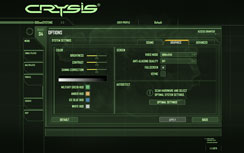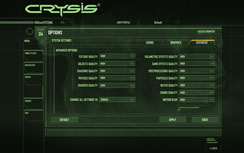AMD ATI Radeon HD 4870 1GB
Written by Tim Smalley
October 6, 2008 | 08:36
Tags: #1gb #260 #280 #4870 #advantage #consumption #difference #evaluation #frame #geforce #gtx #hd #performance #power #radeon #rates #review #rv770

Crysis
Publisher: Electronic ArtsWhat can we say about this game that hasn’t been said already? Crysis was probably the most anticipated game on the PC last year and was released on November 16th 2007.
Crysis is seen by many as the poster boy for DirectX 10 and it will make your system cry, quite literally – it’s a monster! It doesn’t come as much of a surprise then, that the graphics are something special – they’re above and beyond anything we’ve ever seen in a PC game.
We tested the game using the 64-bit executable under both DirectX 9.0 and DirectX 10 with the 1.21 patch applied. We used a custom timedemo recorded from the Laws of Nature level which is more representative of gameplay than the built-in benchmark that renders things much faster than you're going to experience in game. We found that around 27-33 fps in our custom timedemo was sufficient enough to obtain a playable frame rate through the game. It's a little different to other games in that the low frame rates still appear to be quite smooth.
For our testing, we set all quality details to High and forced 8x anisotropic filtering in the driver menu as there is currently no support for it in game. We tested at 1,280 x 1,024, using 0x, 2x and 4x anti-aliasing, 1,680 x 1,050 using 0x and 4x anti-aliasing, 1,920 x 1,200 using 0x and 2xAA and 2,560 x 1,600 with 0xAA. By extensively testing using anti-aliasing in very high resolutions, we'll be pushing even the bleeding edge hardware on test to the limit.
Crysis
1280x1024 0xAA 8xAF, DX10, High Detail
- ATI Radeon HD 4870 X2
- Nvidia GeForce GTX 280
- BFG Tech GeForce GTX 260 OCX Maxcore
- Zotac GeForce GTX 260 AMP!
- Nvidia GeForce GTX 260+
- Nvidia GeForce GTX 260
- ATI Radeon HD 4870 1GB
- ATI Radeon HD 4870 512MB
- Nvidia GeForce 9800 GTX+
- HIS Radeon HD 4850 IceQ 4 TurboX
- Powercolor Radeon HD 4850 PCS+
- ATI Radeon HD 4850
- ATI Radeon HD 3870 X2
- Nvidia GeForce 8800 GT
-
-
58.1
-
29.0
-
-
-
50.2
-
29.0
-
-
-
49.5
-
29.0
-
-
-
45.7
-
26.0
-
-
-
44.2
-
26.0
-
-
-
41.3
-
23.0
-
-
-
39.0
-
22.0
-
-
-
38.6
-
22.0
-
-
-
35.1
-
20.0
-
-
-
33.2
-
18.0
-
-
-
32.9
-
18.0
-
-
-
31.3
-
18.0
-
-
-
29.4
-
13.0
-
-
-
27.4
-
15.0
-
0
10
20
30
40
50
60
Frames Per Second
-
Average
-
Minimum
Crysis
1280x1024 4xAA 8xAF, DX10, High Detail
- ATI Radeon HD 4870 X2
- Nvidia GeForce GTX 280
- BFG Tech GeForce GTX 260 OCX Maxcore
- Zotac GeForce GTX 260 AMP!
- Nvidia GeForce GTX 260+
- Nvidia GeForce GTX 260
- ATI Radeon HD 4870 1GB
- ATI Radeon HD 4870 512MB
- HIS Radeon HD 4850 IceQ 4 TurboX
- Powercolor Radeon HD 4850 PCS+
- ATI Radeon HD 3870 X2
- ATI Radeon HD 4850
- Nvidia GeForce 9800 GTX+
- Nvidia GeForce 8800 GT
-
-
48.4
-
22.0
-
-
-
43.2
-
26.0
-
-
-
42.2
-
25.0
-
-
-
39.1
-
23.0
-
-
-
37.6
-
22.0
-
-
-
35.4
-
21.0
-
-
-
32.7
-
17.0
-
-
-
32.0
-
17.0
-
-
-
26.6
-
13.0
-
-
-
25.9
-
13.0
-
-
-
25.5
-
12.0
-
-
-
24.8
-
12.0
-
-
-
24.0
-
13.0
-
-
-
20.7
-
12.0
-
0
10
20
30
40
50
Frames Per Second
-
Average
-
Minimum
Crysis
1680x1050 0xAA 8xAF, DX10, High Detail
- ATI Radeon HD 4870 X2
- Nvidia GeForce GTX 280
- BFG Tech GeForce GTX 260 OCX Maxcore
- Zotac GeForce GTX 260 AMP!
- Nvidia GeForce GTX 260+
- Nvidia GeForce GTX 260
- ATI Radeon HD 4870 1GB
- ATI Radeon HD 4870 512MB
- Nvidia GeForce 9800 GTX+
- HIS Radeon HD 4850 IceQ 4 TurboX
- Powercolor Radeon HD 4850 PCS+
- ATI Radeon HD 4850
- ATI Radeon HD 3870 X2
- Nvidia GeForce 8800 GT
-
-
45.4
-
22.0
-
-
-
40.1
-
25.0
-
-
-
39.5
-
25.0
-
-
-
36.4
-
23.0
-
-
-
35.3
-
22.0
-
-
-
32.9
-
20.0
-
-
-
31.1
-
18.0
-
-
-
30.8
-
18.0
-
-
-
27.8
-
17.0
-
-
-
26.3
-
16.0
-
-
-
26.0
-
15.0
-
-
-
24.7
-
15.0
-
-
-
22.8
-
11.0
-
-
-
21.8
-
13.0
-
0
10
20
30
40
50
Frames Per Second
-
Average
-
Minimum
Crysis
1680x1050 4xAA 8xAF, DX10, High Detail
- ATI Radeon HD 4870 X2
- Nvidia GeForce GTX 280
- BFG Tech GeForce GTX 260 OCX Maxcore
- Zotac GeForce GTX 260 AMP!
- Nvidia GeForce GTX 260+
- ATI Radeon HD 4870 1GB
- Nvidia GeForce GTX 260
- ATI Radeon HD 4870 512MB
- HIS Radeon HD 4850 IceQ 4 TurboX
- Powercolor Radeon HD 4850 PCS+
- ATI Radeon HD 3870 X2
- ATI Radeon HD 4850
- Nvidia GeForce 9800 GTX+
- Nvidia GeForce 8800 GT
-
-
36.7
-
18.0
-
-
-
32.0
-
21.0
-
-
-
30.0
-
20.0
-
-
-
28.4
-
18.0
-
-
-
27.3
-
17.0
-
-
-
26.7
-
15.0
-
-
-
26.1
-
16.0
-
-
-
25.1
-
12.0
-
-
-
20.5
-
10.0
-
-
-
20.0
-
10.0
-
-
-
19.2
-
8.0
-
-
-
19.2
-
10.0
-
-
-
17.9
-
9.0
-
-
-
14.7
-
9.0
-
0
10
20
30
40
Frames Per Second
-
Average
-
Minimum
Crysis
1920x1200 0xAA 8xAF, DX10, High Detail
- ATI Radeon HD 4870 X2
- Nvidia GeForce GTX 280
- BFG Tech GeForce GTX 260 OCX Maxcore
- ATI Radeon HD 3870 X2
- Zotac GeForce GTX 260 AMP!
- Nvidia GeForce GTX 260+
- ATI Radeon HD 4870 1GB
- ATI Radeon HD 4870 512MB
- Nvidia GeForce GTX 260
- HIS Radeon HD 4850 IceQ 4 TurboX
- Powercolor Radeon HD 4850 PCS+
- Nvidia GeForce 9800 GTX+
- ATI Radeon HD 4850
- Nvidia GeForce 8800 GT
-
-
40.6
-
19.0
-
-
-
32.7
-
20.0
-
-
-
32.2
-
20.0
-
-
-
30.1
-
10.0
-
-
-
29.5
-
18.0
-
-
-
28.6
-
17.0
-
-
-
27.3
-
16.0
-
-
-
26.9
-
16.0
-
-
-
26.7
-
16.0
-
-
-
23.0
-
14.0
-
-
-
22.4
-
14.0
-
-
-
21.6
-
13.0
-
-
-
21.5
-
13.0
-
-
-
17.2
-
10.0
-
0
10
20
30
40
Frames Per Second
-
Average
-
Minimum
Crysis
1920x1200 2xAA 8xAF, DX10, High Detail
- ATI Radeon HD 4870 X2
- Nvidia GeForce GTX 280
- BFG Tech GeForce GTX 260 OCX Maxcore
- Zotac GeForce GTX 260 AMP!
- ATI Radeon HD 4870 1GB
- Nvidia GeForce GTX 260+
- ATI Radeon HD 4870 512MB
- Nvidia GeForce GTX 260
- HIS Radeon HD 4850 IceQ 4 TurboX
- Powercolor Radeon HD 4850 PCS+
- ATI Radeon HD 4850
- ATI Radeon HD 3870 X2
- Nvidia GeForce 9800 GTX+
- Nvidia GeForce 8800 GT
-
-
36.3
-
17.0
-
-
-
29.2
-
19.0
-
-
-
28.2
-
18.0
-
-
-
26.1
-
16.0
-
-
-
25.5
-
15.0
-
-
-
25.2
-
16.0
-
-
-
24.7
-
12.0
-
-
-
23.7
-
14.0
-
-
-
20.5
-
12.0
-
-
-
19.9
-
11.0
-
-
-
19.1
-
11.0
-
-
-
17.7
-
8.0
-
-
-
15.3
-
8.0
-
-
-
13.1
-
7.0
-
0
10
20
30
40
Frames Per Second
-
Average
-
Minimum
On average, the additional 512MB of memory makes very little difference in Crysis, but there are a few instances where it might help to make things a bit smoother or playable. For example, at 1,680 x 1,050 4xAA 8xAF, the improvement is around six percent which is nothing to sniff at considering both cards are running at the same clock speed.
Some would argue that an average frame rate of almost 27 fps, as a worst case, is acceptable, while 25 fps isn't - it's splitting hairs, but playability in Crysis happens in and around the frame rates that we're talking about here. With that said, the performance advantage afforded by the additional memory does mean the Radeon HD 4870 1GB is marginally faster than Nvidia's GeForce GTX 260, but it's not enough to see of the fresh challenge from the GeForce GTX 260+ (or whatever Nvidia's partners choose to call it).











Want to comment? Please log in.